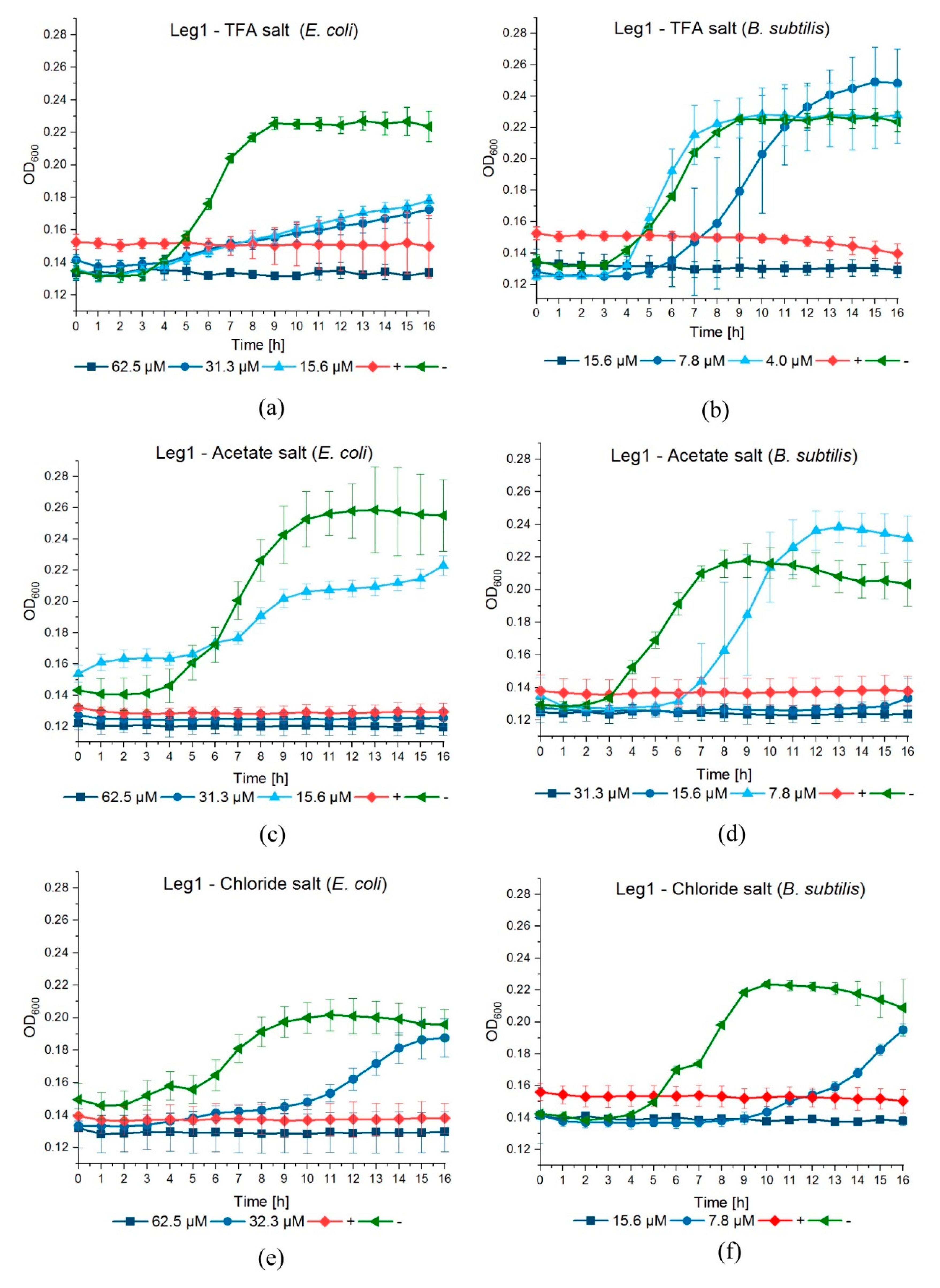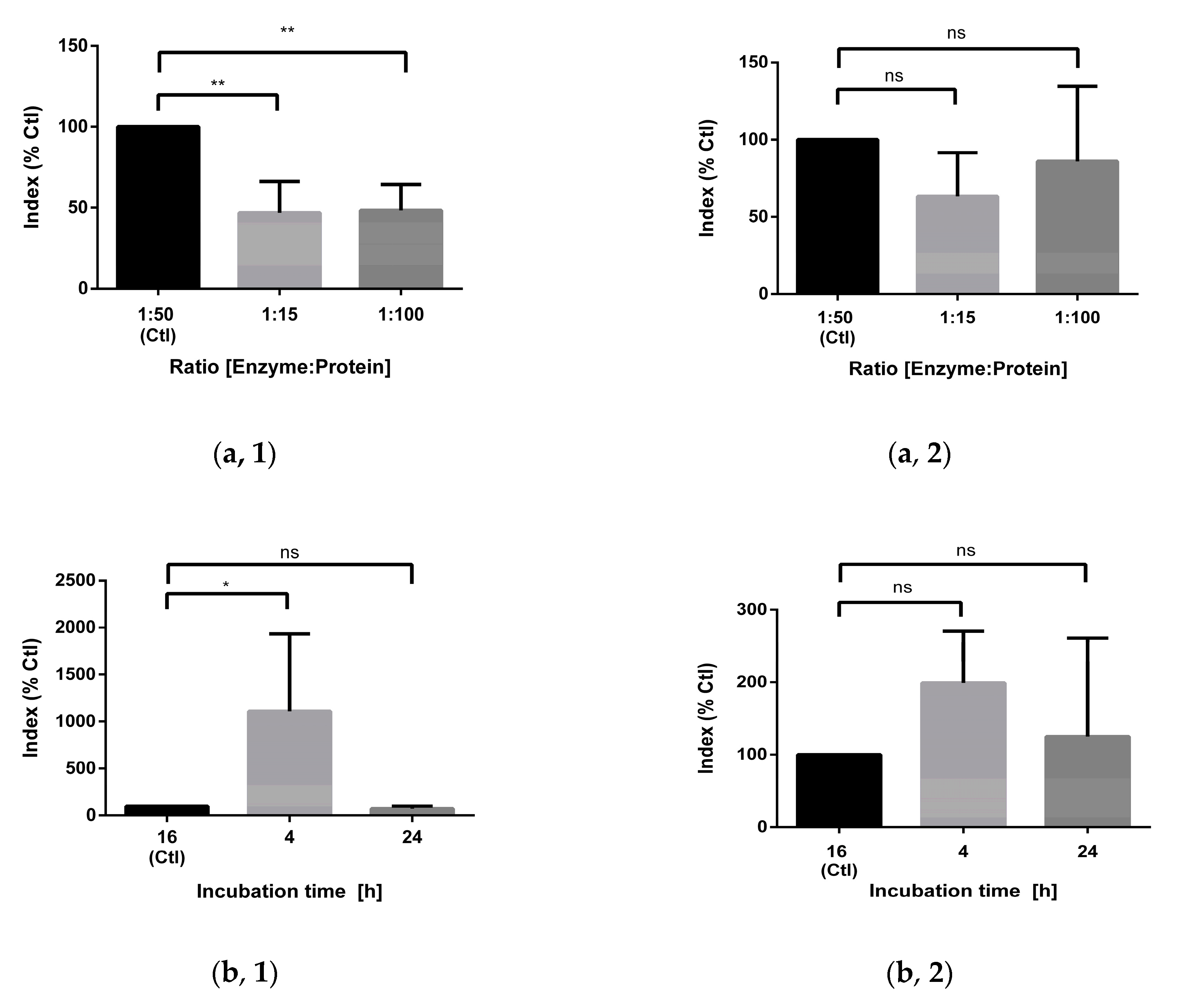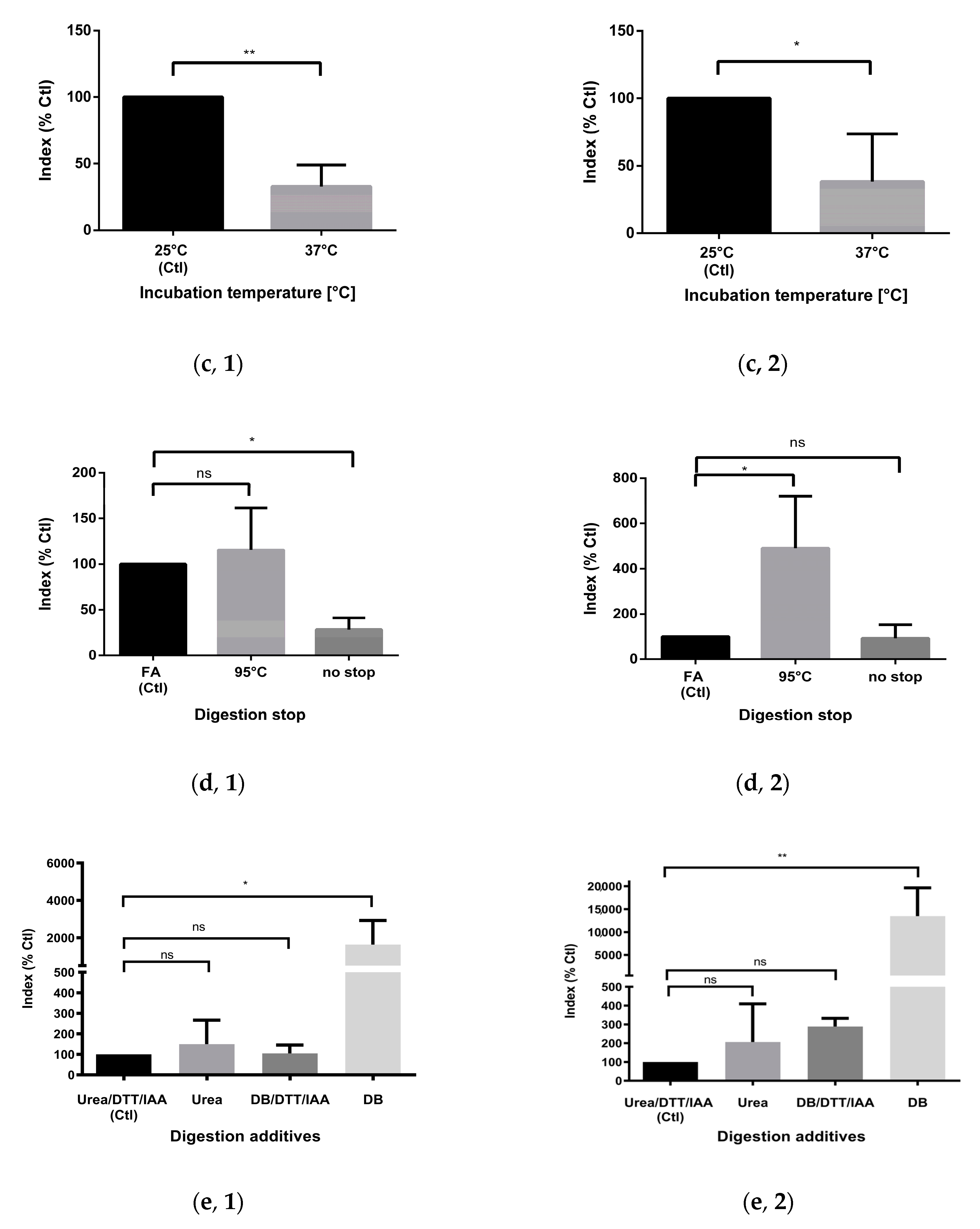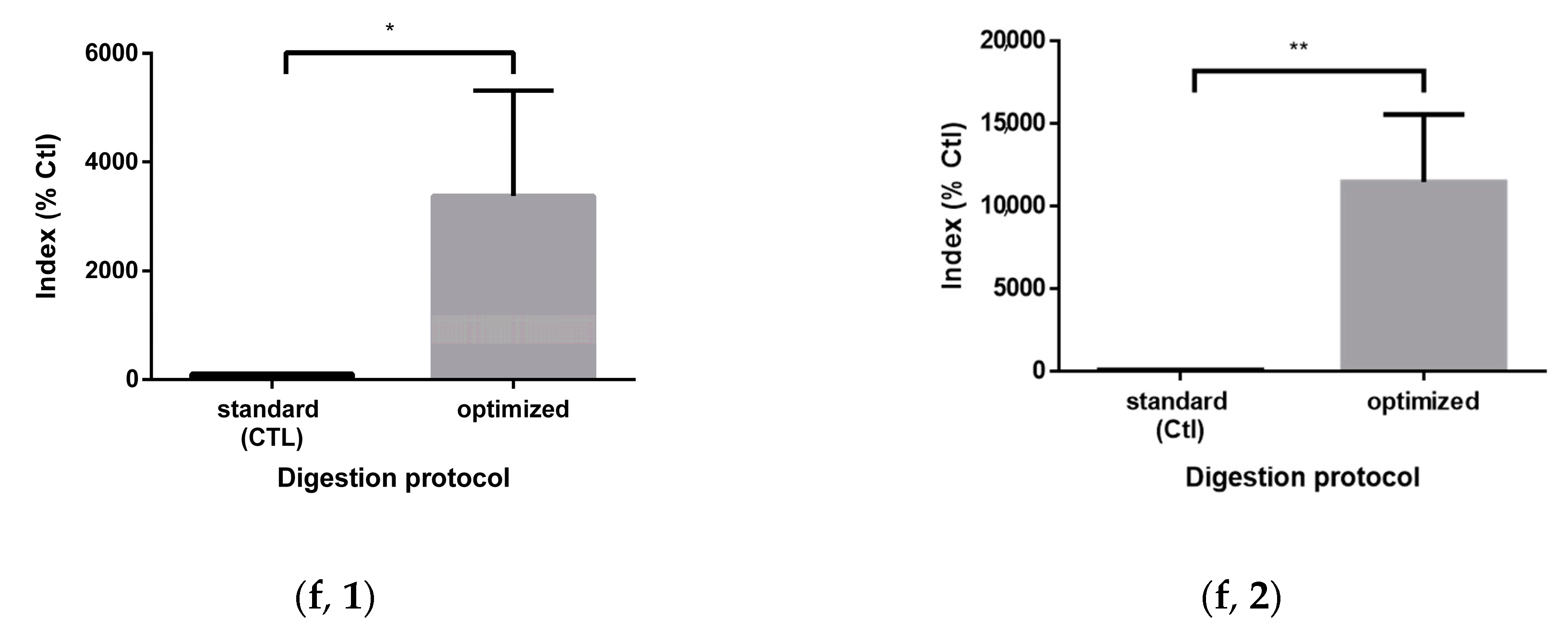Stability and Activity of the Antimicrobial Peptide Leg1 in Solution and on Meat and Its Optimized Generation from Chickpea Storage Protein
Abstract
1. Introduction
2. Materials and Methods
2.1. Peptide Synthesis
2.2. Bacterial Strains and Culture Conditions
2.3. Stability Test in Solution
2.4. Antimicrobial Assays at pH 5.0, pH 6.8, 20 °C, and 37 °C
2.5. Stability of Leg1 on Meat
2.6. Antimicrobial Activity of Leg1 Using Different Counter-Ions
2.7. Relative Quantification of Leg1 and Leg2 by UHPLC–MS/MS-sMRM
2.8. Optimization of Digestion Parameters
2.9. Statistical Analysis
3. Results and Discussion
3.1. Stability of Leg1 in Solution
3.2. MIC of Leg1 Dependent on pH and Temperature
3.3. Bactericidal Activity of Leg1 on Meat
3.4. Influence of the Counter-Ion on the Antimicrobial Activity of Leg1
3.5. Optimization of the Chymotryptic Release of Leg1 and Leg2 from Chickpea Storage Protein
4. Conclusions
Supplementary Materials
Author Contributions
Funding
Institutional Review Board Statement
Informed Consent Statement
Data Availability Statement
Acknowledgments
Conflicts of Interest
References
- Saucier, L. Microbial spoilage, quality and safety within the context of meat sustainability. Meat Sci. 2016, 120, 78–84. [Google Scholar] [CrossRef]
- Zasloff, M. Antimicrobial peptides of multicellular organisms. Nature 2002, 415, 389–395. [Google Scholar] [CrossRef] [PubMed]
- Kang, H.K.; Kim, C.; Seo, C.H.; Park, Y. The therapeutic applications of antimicrobial peptides (AMPs): A patent review. J. Microbiol. 2017, 55, 1–12. [Google Scholar] [CrossRef] [PubMed]
- Dalabasmaz, S.; Pischetsrieder, M. Peptidomics in food. In Comprehensive Foodomics; Cifuentes, A., Ed.; Elsevier: Cambridge, MA, USA, 2021; pp. 651–665. [Google Scholar]
- Theolier, J.; Fliss, I.; Jean, J.; Hammami, R. MilkAMP: A comprehensive database of antimicrobial peptides of dairy origin. Dairy Sci. Technol. 2014, 94, 181–193. [Google Scholar] [CrossRef]
- Liu, Y.F.; Eichler, J.; Pischetsrieder, M. Virtual screening of a milk peptide database for the identification of food-derived antimicrobial peptides. Mol. Nutr. Food Res. 2015, 59, 2243–2254. [Google Scholar] [CrossRef] [PubMed]
- Liu, Y.; Pischetsrieder, M. Identification and Relative Quantification of Bioactive Peptides Sequentially Released during Simulated Gastrointestinal Digestion of Commercial Kefir. J. Agric. Food Chem. 2017, 65, 1865–1873. [Google Scholar] [CrossRef]
- Nebbia, S.; Lamberti, C.; Lo Bianco, G.; Cirrincione, S.; Laroute, V.; Cocaign-Bousquet, M.; Cavallarin, L.; Giuffrida, M.G.; Pessione, E. Antimicrobial Potential of Food Lactic Acid Bacteria: Bioactive Peptide Decrypting from Caseins and Bacteriocin Production. Microorganisms 2021, 9, 65. [Google Scholar] [CrossRef]
- Miao, J.; Guo, H.; Chen, F.; Zhao, L.; He, L.; Ou, Y.; Huang, M.; Zhang, Y.; Guo, B.; Cao, Y.; et al. Antibacterial Effects of a Cell-Penetrating Peptide Isolated from Kefir. J. Agric. Food Chem. 2016, 64, 3234–3242. [Google Scholar] [CrossRef]
- Toldra, F.; Gallego, M.; Reig, M.; Aristoy, M.C.; Mora, L. Recent Progress in Enzymatic Release of Peptides in Foods of Animal Origin and Assessment of Bioactivity. J. Agric. Food Chem. 2020, 68, 12842–12855. [Google Scholar] [CrossRef]
- Maestri, E.; Marmiroli, M.; Marmiroli, N. Bioactive peptides in plant-derived foodstuffs. J. Proteomics 2016, 147, 140–155. [Google Scholar] [CrossRef]
- Heymich, M.-L.; Friedlein, U.; Trollmann, M.; Schwaiger, K.; Böckmann, R.A.; Pischetsrieder, M. Generation of antimicrobial peptides Leg1 and Leg2 from chickpea storage protein, active against food spoilage bacteria and foodborne pathogens. Food Chem. 2021, 347, 128917. [Google Scholar] [CrossRef] [PubMed]
- Heymich, M.-L.; Nißl, L.; Hahn, D.; Noll, M.; Pischetsrieder, M. Antioxidative, antifungal and additive activity of the antimicrobial peptides Leg1 and Leg2 from chickpea. Foods 2021, 10, 585. [Google Scholar] [CrossRef] [PubMed]
- Shock, E.L. Stability of peptides in high-temperature aqueous solutions. Geochim. Cosmochim. Acta 1992, 56, 3481–3491. [Google Scholar] [CrossRef]
- Ginsburg, A.; Schachman, H.K. Studies on the enzymatic breakdown of proteins. I. Action of chymotrypsin on insulin. J. Biol. Chem. 1960, 235, 108–114. [Google Scholar] [CrossRef]
- Bell, L.N. Peptide stability in solids and solutions. Biotechnol. Prog. 1997, 13, 342–346. [Google Scholar] [CrossRef]
- Radzicka, A.; Wolfenden, R. Rates of uncatalyzed peptide bond hydrolysis in neutral solution and the transition state affinities of proteases. J. Am. Chem. Soc. 1996, 118, 6105–6109. [Google Scholar] [CrossRef]
- Toldrá, F.; Reig, M. Enzymes in meat and fish. In Improving and Tailoring Enzymes for Food Quality and Functionality; Yada, R.Y., Ed.; Woodhead Publishing: Sawton, Cambridge, UK, 2015; pp. 199–212. [Google Scholar]
- Arshad, M.S.; Kwon, J.-H.; Imran, M.; Sohaib, M.; Aslam, A.; Nawaz, I.; Amjad, Z.; Khan, U.; Javed, M. Plant and bacterial proteases: A key towards improving meat tenderization, a mini review. Cogent Food Agric. 2016, 2, 1261780. [Google Scholar] [CrossRef]
- Meltretter, J.; Wust, J.; Dittrich, D.; Lach, J.; Ludwig, J.; Eichler, J.; Pischetsrieder, M. Untargeted proteomics-based profiling for the identification of novel processing-induced protein modifications in milk. J. Proteome Res. 2020, 19, 805–818. [Google Scholar] [CrossRef]
- Augner, K.; Eichler, J.; Utz, W.; Pischetsrieder, M. Influence of nonenzymatic posttranslational modifications on constitution, oligomerization and receptor binding of S100A12. PLoS ONE 2014, 9, e113418. [Google Scholar] [CrossRef]
- Sikora, K.; Neubauer, D.; Jaskiewicz, M.; Kamysz, W. Citropin 1.1 trifluoroacetate to chloride counter-ion exchange in HCl-saturated organic solutions: An alternative approach. Int. J. Pept. Res. Ther. 2018, 24, 265–270. [Google Scholar] [CrossRef]
- Kamath, K.S.; Vasavada, M.S.; Srivastava, S. Proteomic databases and tools to decipher post-translational modifications. J. Proteom. 2011, 75, 127–144. [Google Scholar] [CrossRef] [PubMed]
- Manning, M.C.; Chou, D.K.; Murphy, B.M.; Payne, R.W.; Katayama, D.S. Stability of protein pharmaceuticals: An update. Pharm. Res. 2010, 27, 544–575. [Google Scholar] [CrossRef] [PubMed]
- Baindara, P.; Chaudhry, V.; Mittal, G.; Liao, L.M.; Matos, C.O.; Khatri, N.; Franco, O.L.; Patil, P.B.; Korpole, S. Characterization of the Antimicrobial Peptide Penisin, a Class Ia Novel Lantibiotic from Paenibacillus sp. Strain A3. Antimicrob. Agents Chemother. 2016, 60, 580–591. [Google Scholar] [CrossRef] [PubMed]
- Sun, D.; Wu, S.; Jing, C.; Zhang, N.; Liang, D.; Xu, A. Identification, synthesis and characterization of a novel antimicrobial peptide HKPLP derived from Hippocampus kuda Bleeker. J. Antibiot. 2012, 65, 117–121. [Google Scholar] [CrossRef] [PubMed]
- Ebbensgaard, A.; Mordhorst, H.; Overgaard, M.T.; Nielsen, C.G.; Aarestrup, F.M.; Hansen, E.B. Comparative evaluation of the antimicrobial activity of different antimicrobial peptides against a range of pathogenic bacteria. PLoS ONE 2015, 10, e0144611. [Google Scholar] [CrossRef]
- Georgalaki, M.D.; Van Den Berghe, E.; Kritikos, D.; Devreese, B.; Van Beeumen, J.; Kalantzopoulos, G.; De Vuyst, L.; Tsakalidou, E. Macedocin, a food-grade lantibiotic produced by Streptococcus macedonicus ACA-DC 198. Appl. Environ. Microbiol. 2002, 68, 5891–5903. [Google Scholar] [CrossRef]
- Brul, S.; Coote, P. Preservative agents in foods. Mode of action and microbial resistance mechanisms. Int. J. Food Microbiol. 1999, 50, 1–17. [Google Scholar] [CrossRef]
- Sikora, K.; Jaskiewicz, M.; Neubauer, D.; Bauer, M.; Bartoszewska, S.; Baranska-Rybak, W.; Kamysz, W. Counter-ion effect on antistaphylococcal activity and cytotoxicity of selected antimicrobial peptides. Amino Acids 2018, 50, 609–619. [Google Scholar] [CrossRef]
- Greber, K.E.; Dawgul, M.; Kamysz, W.; Sawicki, W. Cationic net charge and counter ion type as antimicrobial activity determinant factors of short lipopeptides. Front. Microbiol. 2017, 8, 123. [Google Scholar] [CrossRef]
- Castiglia, F.; Zevolini, F.; Riolo, G.; Brunetti, J.; De Lazzari, A.; Moretto, A.; Manetto, G.; Fragai, M.; Algotsson, J.; Evenas, J.; et al. NMR study of the secondary structure and biopharmaceutical formulation of an active branched antimicrobial peptide. Molecules 2019, 24, 4290. [Google Scholar] [CrossRef]
- Andersson, L.; Blomberg, L.; Flegel, M.; Lepsa, L.; Nilsson, B.; Verlander, M. Large-scale synthesis of peptides. Pept. Sci. 2000, 55, 227–250. [Google Scholar] [CrossRef]
- Muller, T.; Winter, D. Systematic evaluation of protein reduction and alkylation reveals massive unspecific side effects by iodine-containing reagents. Mol. Cell. Proteom. 2017, 16, 1173–1187. [Google Scholar] [CrossRef] [PubMed]
- Mouchahoir, T.; Schiel, J.E. Development of an LC-MS/MS peptide mapping protocol for the NISTmAb. Anal. Bioanal. Chem. 2018, 410, 2111–2126. [Google Scholar] [CrossRef] [PubMed]
- Al-Sahlany, S.T.G.; Altemimi, A.B.; Al-Manhel, A.J.A.; Niamah, A.K.; Lakhssassi, N.; Ibrahim, S.A. Purification of bioactive peptide with antimicrobial properties produced by Saccharomyces cerevisiae. Foods 2020, 9, 324. [Google Scholar] [CrossRef] [PubMed]
- Jakubczyk, A.; Karas, M.; Rybczynska-Tkaczyk, K.; Zielinska, E.; Zielinski, D. Current trends of bioactive peptides-new sources and therapeutic effect. Foods 2020, 9, 846. [Google Scholar] [CrossRef]




| Peptide Sequence | Theoretical Mass (Da) | RT 1 (min) | Precursor Ion (m/z) | Quantifier Ion (m/z) | Collision Energy (eV) | Confirmation Ions (m/z) | |
|---|---|---|---|---|---|---|---|
| RIKTVTSFDLPALRFLKL (Leg1) | 2118.59 | 36.1 | 530.334+ | 957.021+ | 30.4 | 710.422+ | 581.342+ |
| RIKTVTSFDLPALRWLKL (Leg2) | 2157.62 | 36.7 | 540.084+ | 729.932+ | 27.0 | 686.412+ | 780.452+ |
| QILQWQ | 814.94 | 25.2 | 408.222+ | 242.163+ | 22.6 | 333.162+ | 355.231+ |
| MIC (µM) at Day(s) | |||||||
|---|---|---|---|---|---|---|---|
| 0 | 1 | 3 | 7 | 14 | 21 | 28 | |
| Leg1 | 62.5 | 62.5 | 62.5 | 62.5 | 125 | 125 | 125 |
| Leg2 | 62.5 | 62.5 | 62.5 | 62.5 | 125 | 125 | 125 |
| Nisin | 125 | 125 | 125 | 125 | 125 | 125 | 125 |
| Sodium benzoate | 40,000 | 40,000 | 40,000 | 40,000 | 40,000 | 40,000 | 40,000 |
| Potassium sorbate | 20,000 | 20,000 | 20,000 | 20,000 | 20,000 | 20,000 | 20,000 |
| Sodium nitrite | 10,000 | 10,000 | 10,000 | 10,000 | 10,000 | 10,000 | 10,000 |
| MIC in µM (mg/mL) at Temperatures | ||||
|---|---|---|---|---|
| 37 °C | 20 °C | 37 °C | 20 °C | |
| E. coli | B. subtilis | |||
| Leg1 | 62.5 (0.13) | 15.6 (0.03) | 15.6 (0.03) | 7.8 (0.02) |
| Leg2 | 62.5 (0.13) | 15.6 (0.03) | 15.6 (0.03) | 4.0 (0.01) |
| Nisin | 125 (0.42) | 15.6 (0.05) | 7.81 (0.03) | 1.0 (0.004) |
| Sodium benzoate | 40,000 (5.8) | 20,000 (2.9) | 80,000 (11.5) | 10,000 (1.5) |
| Potassium sorbate | 20,000 (3.0) | 20,000 (3.0) | 160,000 (24.0) | 20,000 (3.0) |
| Sodium nitrite | 10,000 (0.68) | 20,000 (1.36) | 40,000 (2.76) | 20,000 (1.36) |
| MIC in µM (mg/mL) at pH | ||||
|---|---|---|---|---|
| 6.8 | 5.0 | 6.8 | 5.0 | |
| E. coli | B. subtilis | |||
| Leg1 | 62.5 (0.13) | 62.5 (0.13) | 15.6 (0.03) | 15.6 (0.03)) |
| Leg2 | 62.5 (0.13) | 62.5 (0.13) | 15.6 (0.03) | 15.6 (0.03) |
| Nisin | 125 (0.42) | 125 (0.42) | 7.81 (0.03) | 7.81 (0.03)) |
| Sodium benzoate | 40,000 (5.8) | 40,000 (5.8)) | 40,000 (5.8) | 40,000 (5.8) |
| Potassium sorbate | 40,000 (6.0) | 40,000 (6.0) | 80,000 (12.0) | 80,000 (12.0) |
| Sodium nitrite | 40,000 (2.76) | <2500 | 40,000 (2.76) | <2500 |
| MBC in µM (mg/mL) | ||
|---|---|---|
| E. coli | B. subtilis | |
| Leg1 | 125 (0.26) | 15.6 (0.03) |
| Nisin | 125 (0.42) | 15.6 (0.052) |
| Sodium benzoate | 1,280,000 (184.0) | 640,000 (92.0) |
| Potassium sorbate | 640,000 (96.0) | 1,280,000 (192.0) |
| Sodium nitrite | 640,000 (44.10) | 320,000 (22.08) |
| Counter-Ion | MIC (µM) | |
|---|---|---|
| E. coli | B. subtilis | |
| TFA− | 62.5 | 15.6 |
| acetate | 62.5 | 15.6 |
| chloride | 62.5 | 15.6 |
Publisher’s Note: MDPI stays neutral with regard to jurisdictional claims in published maps and institutional affiliations. |
© 2021 by the authors. Licensee MDPI, Basel, Switzerland. This article is an open access article distributed under the terms and conditions of the Creative Commons Attribution (CC BY) license (https://creativecommons.org/licenses/by/4.0/).
Share and Cite
Heymich, M.-L.; Srirangan, S.; Pischetsrieder, M. Stability and Activity of the Antimicrobial Peptide Leg1 in Solution and on Meat and Its Optimized Generation from Chickpea Storage Protein. Foods 2021, 10, 1192. https://doi.org/10.3390/foods10061192
Heymich M-L, Srirangan S, Pischetsrieder M. Stability and Activity of the Antimicrobial Peptide Leg1 in Solution and on Meat and Its Optimized Generation from Chickpea Storage Protein. Foods. 2021; 10(6):1192. https://doi.org/10.3390/foods10061192
Chicago/Turabian StyleHeymich, Marie-Louise, Showmika Srirangan, and Monika Pischetsrieder. 2021. "Stability and Activity of the Antimicrobial Peptide Leg1 in Solution and on Meat and Its Optimized Generation from Chickpea Storage Protein" Foods 10, no. 6: 1192. https://doi.org/10.3390/foods10061192
APA StyleHeymich, M.-L., Srirangan, S., & Pischetsrieder, M. (2021). Stability and Activity of the Antimicrobial Peptide Leg1 in Solution and on Meat and Its Optimized Generation from Chickpea Storage Protein. Foods, 10(6), 1192. https://doi.org/10.3390/foods10061192






